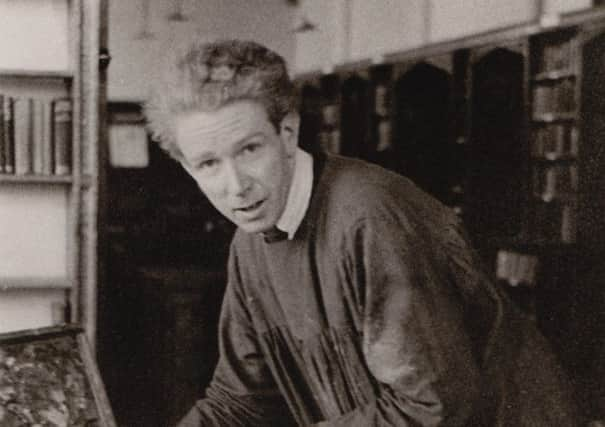Obituary: Derek Clarke, MBE, RSA, artist and teacher


IN A distinguished career, Derek Clarke was a painter and draughtsman of imagination and integrity, who always displayed an innovative use of colour. He avoided reproducing former styles or following fashions: latest trends were not Clarke’s way. “Never,” he once said, “have I made two paintings the same…each work springs from a uniquely imagined inspiration.”
Clarke also was a fine water-colourist, becoming a member of the Royal Scottish Society of Watercolourists. He taught at the Edinburgh School of Art in the post-war years, instructing many demobbed service men with a special care and insight. That zeal and passion for art was reflected in his own paintings. He preserved an enthusiasm and willingness to explore fresh mediums all his life.
Advertisement
Hide AdAdvertisement
Hide AdVictoria Crowe, the current deputy president of the Royal Scottish Academy, told The Scotsman: “I first met Derek when I joined the staff of the Edinburgh College of Art in 1968. I found Derek an enthusiastic teacher and communicator, passing on to his students a rigorous and disciplined approach to drawing, probably reflecting the influence of the Slade, where he had studied before the war. He had a great interest in anatomy and a passion for painting that remained undimmed throughout his long creative life.”
On 1 January, the RSA opened a “celebratory exhibition of beautiful paintings and research work by our oldest member, Derek Clarke RSA”. The impressive exhibition – pictures covering 80 years – was to mark Clarke’s 100th birthday: representing his extensive oeuvre, from the pre-war years to the present day.
Derek Clarke attended Ampleforth College and then studied at the Slade School of Art in London, attending classes by Augustus John where he learnt the importance of drawing. After graduating in 1935, Clarke began his career as a portrait painter – an early example was of the pianist Elizabeth Poston in 1936. She wears a dark, colourless dress, but the eye is immediately drawn to the brilliant yellow chair and curtains. The portrait displays a strength and confidence in Clarke’s brush work and mastery of the fusing of colours. He also spent much time painting and sketching in Conemarra on the west coast of Ireland.
During the Second World War, Clarke was an officer in the Durham Light Infantry, serving in Tunisia. In 1943, he was severely wounded in the spine and spent a year convalescing in London. He continued painting voraciously, but Clarke avoided the bomb sites and depressing atmosphere of wartime London and concentrated on depicting bright and optimistic scenes. His canvases were full of colourful images and won considerable critical approval. One, a biblical composition of the Gadarene Swine, won praise from Stanley Spencer. The painting is now, unfortunately, lost. In later years Clarke was to paint Homage to Spencer, with the artist gamely pushing a pram full of an easel and a large umbrella.
The years after the war were not easy and, after some time back in Ireland, Clarke was invited in 1947 by Robert Lyon, principal of Edinburgh College of Art, to join the staff of the college. Lyon was keen to expand the college and bring innovative new ideas to the teaching of art. He offered Clarke a post in the Drawing and Painting School. Clarke enthusiastically joined the college and worked with such eminent personalities as Robin Philipson.
Clarke taught at the college until 1978, continuing to do portraits of distinguished academics and military figures. But he took a keen interest in his students and offered advice in a most constructive manner. His students included such future luminaries as Elizabeth Blackadder and John Bellany. It was, therefore, highly appropriate that sharing the RSA exhibition this year with Clarke were paper works by Bellany.
In 1957, Clarke painted a mural in the arch over the altar of his church, the Sacred Heart, Lauriston. It was a celebration of the congregation – its members, parishioners and priests. But in the Sixties it was covered over after an edict from the Vatican decreed that murals should be simplified. In an interview on BBC Scotland News last month, a spry Clarke said: “I am hoping after I have died they can unveil the mural. It’s only covered over with wallpaper.”
But it is his delightful paintings for which he will be remembered. The tranquillity of Twilight, St Abbs Head, the charm of a scene in Inverleith Park (with the sundial imprinted appropriately for a centenarian, “How sweet is life, alas how swift”), the bleak and brooding crags of Sutherland and the relaxed joy of the portrait of Elizabeth Joseph. All reflect his dedication and love of life and painting.
Advertisement
Hide AdAdvertisement
Hide AdClarke remained a devout man all his life and an ardent supporter of the Catholic Church. His canvas, Lazarus in the Bosom of Abraham, will be brought from the Chapter House for the funeral mass at St Mary’s Cathedral, Edinburgh, on Friday. Clarke also did a most dignified portrait of Cardinal Basil Hume and many of his works are to be seen in other Scottish churches.
Clarke was made a full Academician in 2005 and an MBE this year. His first wife, Ann, died and he is survived by his second wife Pat and his three children from his first marriage. Another son predeceased him.